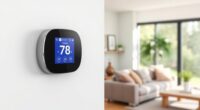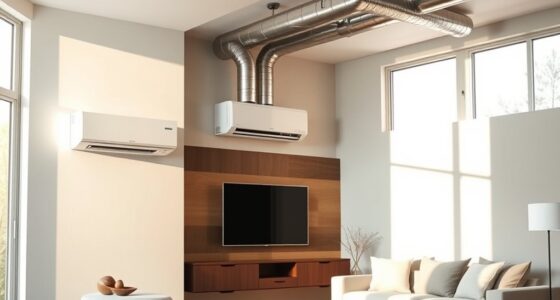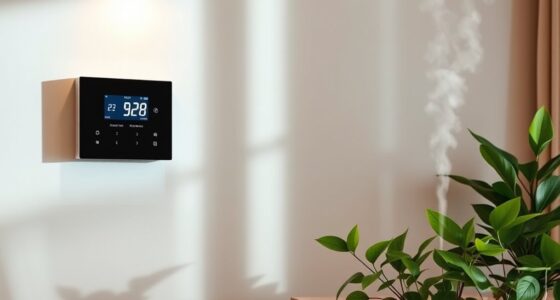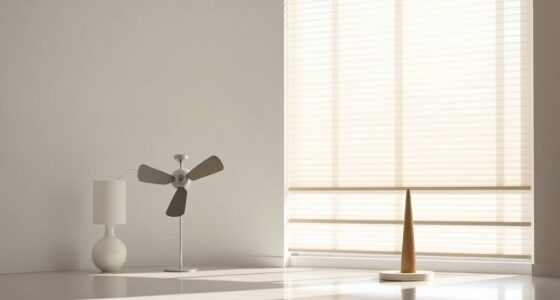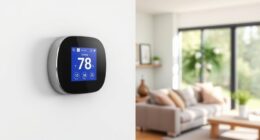To manage indoor humidity for comfort and health, keep levels balanced with proper device care and placement. Regularly clean and maintain your humidifiers or dehumidifiers, and use distilled water to prevent buildup. Position units in central, damp areas away from drafts, and check filters often. This approach helps prevent mold, respiratory issues, and property damage. By following these tips, you’ll create a healthier, more comfortable environment—more insights on effective strategies await you.
Key Takeaways
- Regularly clean and maintain humidifiers and dehumidifiers to prevent mold, bacteria, and allergen buildup.
- Place dehumidifiers in damp areas and elevate them for even moisture removal and optimal efficiency.
- Use distilled or filtered water in humidifiers to reduce mineral deposits and improve air quality.
- Monitor indoor humidity levels with a hygrometer, keeping them between 30-50% for comfort and health.
- Balance device placement and maintenance practices to prevent mold growth, structural damage, and respiratory issues.
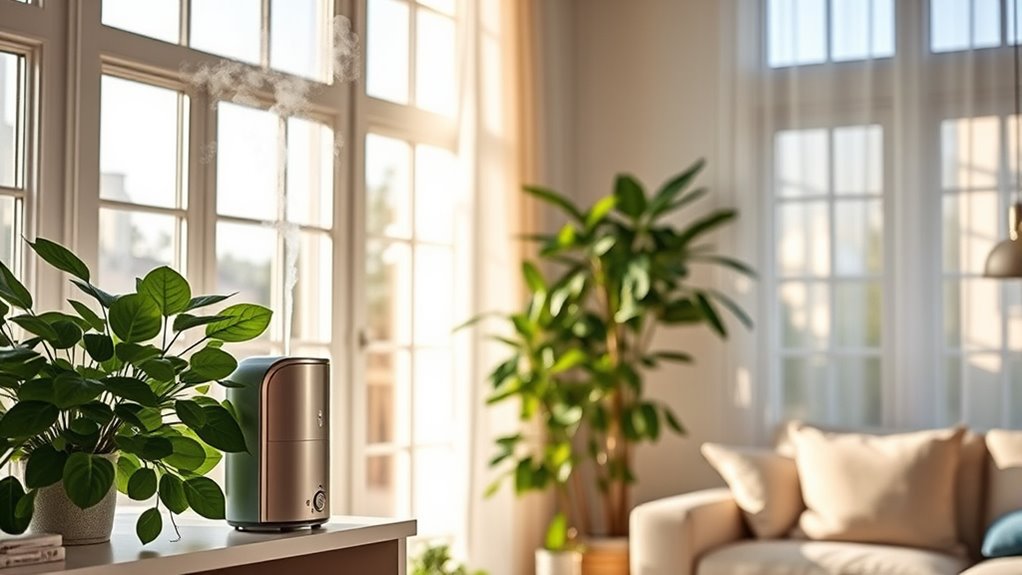
Maintaining proper indoor humidity levels is essential for creating a comfortable and healthy living environment. When your home’s humidity is too high or too low, it can lead to discomfort, health issues, and even damage to your property. To keep humidity in check, you need to understand how to properly care for your humidifiers and dehumidifiers, including their placement and maintenance routines.
Humidifier maintenance is crucial because a poorly maintained unit can become a breeding ground for mold, bacteria, and other allergens. Regularly cleaning your humidifier helps prevent the buildup of mineral deposits and mold that can be released into the air, potentially causing respiratory problems or allergic reactions. Be sure to follow the manufacturer’s instructions for cleaning, which often involve emptying and drying the tank daily and thoroughly disinfecting it weekly. Using distilled or filtered water also minimizes mineral deposits and contaminants, ensuring healthier air quality. Additionally, replacing filters when necessary and inspecting the unit for signs of wear keeps it functioning efficiently and safely. Proper humidifier maintenance ensures that your device effectively adds moisture without introducing health risks.
Regularly clean and disinfect your humidifier to prevent mold, bacteria, and allergens for healthier indoor air.
On the other hand, dehumidifier placement plays a vital role in effectively reducing excess moisture. You want to position your dehumidifier in areas prone to dampness, such as basements, laundry rooms, or bathrooms. Keep the unit elevated on a level surface and away from walls or furniture that could obstruct airflow. This promotes optimal air circulation and prevents the unit from working harder than needed. Placing the dehumidifier in a central location within the room allows for even moisture removal, making your efforts more efficient. Be mindful of door and window placement, as drafts can influence humidity levels and cause the dehumidifier to cycle excessively or insufficiently. Remember, a dehumidifier isn’t a set-it-and-forget-it device; regular checks to ensure it’s functioning properly and that the air filter is clean will help maintain a consistent indoor humidity level. Incorporating proper airflow management can further enhance the effectiveness of your dehumidification efforts.
Balancing humidifier maintenance and dehumidifier placement gives you the best control over indoor humidity. When you keep your humidifier clean and well-maintained, it works more efficiently, providing comfortable moisture levels during dry seasons. Proper placement of your dehumidifier ensures you’re removing excess moisture effectively, preventing mold growth and structural damage. Together, these practices help you create a healthier, more comfortable living space where you can breathe easier and enjoy a consistent environment. Remember, managing humidity isn’t just about using these devices; it’s about maintaining and positioning them wisely to optimize their performance and your well-being.
Frequently Asked Questions
How Does Indoor Humidity Affect Allergy Symptoms?
You’ll notice allergy symptoms worsen when indoor humidity is too high or low. High humidity promotes mold proliferation and makes airborne allergens like dust mites thrive, triggering your allergies. On the other hand, low humidity can dry out your nasal passages, making you more sensitive to allergens. Keeping indoor humidity between 40-50% helps reduce mold growth and airborne allergens, easing your allergy symptoms and improving your comfort and health.
What Are the Best Tools to Measure Indoor Humidity Accurately?
You should use a reliable hygrometer to measure indoor humidity accurately. Digital hygrometers often provide precise readings and are easy to calibrate, ensuring consistent results. Analog hygrometers can be accurate too, but they require calibration checks, often using a salt test. To get the best results, regularly calibrate your hygrometer, regardless of the type, for accurate humidity monitoring and maintaining a comfortable environment.
Can Humidifiers Cause Mold Growth Indoors?
Humidifiers can cause mold growth if you don’t practice proper humidity control. While they add necessary moisture, excess humidity creates a perfect environment for mold, especially in hidden areas. To prevent mold, regularly clean your humidifier, use a hygrometer to monitor humidity levels, and keep indoor humidity between 30-50%. Proper mold prevention guarantees a healthier indoor environment and avoids potential respiratory issues.
How Often Should I Clean My Dehumidifier?
You should clean your dehumidifier at least once a month to prevent mold and bacteria buildup. Regular maintenance frequency guarantees it works efficiently and safely. Don’t forget to replace the filter every 3 to 6 months, or as recommended by the manufacturer, to keep the unit running smoothly. Promptly clear out any collected water and wipe down surfaces to maintain good indoor air quality and prevent mold growth.
What Humidity Level Is Ideal for Different Seasons?
Imagine you live in a humid climate; in summer, keep your indoor humidity between 40-50% by adjusting your dehumidifier accordingly. In winter, lower it to around 30-40% to prevent mold and dryness. Seasonal adjustments are key—set your humidity thresholds based on outside conditions. This balance helps maintain comfort and health year-round, preventing issues like condensation or respiratory discomfort as seasons change.
Conclusion
By mastering indoor humidity, you create a cozy oasis where the air feels just right—neither too dry nor too damp. Imagine walking into a room where the air gently caresses your skin, and your breathing feels effortless. When you keep humidity balanced, you nurture a healthier environment, free from mold, allergens, and discomfort. Take control, and turn your space into a haven of comfort and wellness, where every breath feels fresh and revitalizing.

